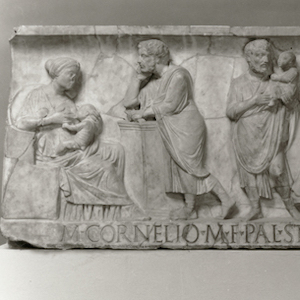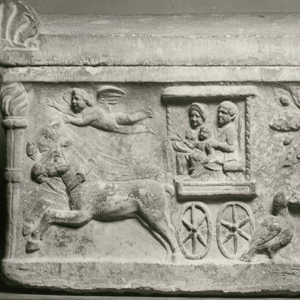Short Teaching Module: Roman Children’s Sarcophagi
Overview
I use images of two Roman marble sarcophagi for topics on children and childhood in undergraduate courses on ancient society, family, gender, representations, and historiography. The sarcophagi can be used to study one period of antiquity or to examine changing notions of childhood over time. My aim in using the sarcophagi is to increase students' awareness of the rich variety of accessible material sources about Roman society—especially archaeological resources such as art, architecture, inscriptions, and topography—that can supplement traditional literary sources. A careful analysis of images from an unfamiliar society can help students already exposed to visual material in their daily lives become more discriminating in their interpretations. The primary sources referenced in this module can be viewed in the Primary Sources folder below. Click on the images or text for more information about the source.
This short teaching module includes historical context and guidance on introducing and discussing the two primary sources.
Primary Sources
Teaching Strategies
Why I Taught the Sources
I use images of two Roman marble sarcophagi for topics on children and childhood in undergraduate courses on ancient society, family, gender, representations, and historiography. The sarcophagi can be used to study one period of antiquity or to examine changing notions of childhood over time.
My aim in using the sarcophagi is to increase students' awareness of the rich variety of accessible material sources about Roman society—especially archaeological resources such as art, architecture, inscriptions, and topography—that can supplement traditional literary sources. A careful analysis of images from an unfamiliar society can help students already exposed to visual material in their daily lives become more discriminating in their interpretations.
Students' present-day interest in children and childhood—in daily life and in academic studies—is a good basis on which to build. But there is a danger of applying our own modern, Western attitudes and values to other societies. Studying artifacts and texts from a different society raises questions of cultural differences. One basic question is whether childhood in pre-modern societies was recognized as a separate stage of life and children were valued; this has been debated since Ariès' book of 1962. Roman society of the first two or three centuries (CE) provides material to help students to enter this debate and make their own assessments.
How I Introduce the Sources
After providing a chronological background and introducing issues such as class and status, gender, urban context, and political structure earlier in the semester, I assign: Ariès, Centuries of Childhood, at least the Introduction; and Letter 4.2 of The Letters of Pliny the Younger. My aim is provide students with the evidence to challenge Ariès' claim about the "ignorance of childhood" in pre-modern ages that relied on a small range of literary sources.
In order to do so, I provide an introductory lecture on the history of childhood studies and on available sources (including the nature of the material as well as the hazards of surviving literary, legal, archaeological sources). I also provide images of materials such as epitaphs, sculptures, and wall paintings related to children and Rome to stimulate thinking about the range of representations available. Students then divide into smaller groups of 10 to 15 to examine primary sources.
Reading the Sources
In these smaller groups, we analyze Pliny's apparently unsympathetic comments on the death of Regulus' son in the context of upper-class Roman male expectations of fatherhood, emotions, and Pliny's deep hostility to Regulus. Pliny's letter also shows the independent wealth of a mother and the possibility of a young male coming into independent wealth, either by the death of his father or by the legal technicality of being freed ("sold") from the power (patria potestas) of his father.
The comparatively large quantity of funerary commemoration of prematurely-dead children helps put Regulus' grief into perspective. Regulus' son had survived early childhood, so his death, in his early teens, was the more tragic.
I also project images of various funerary items, including the two sarcophagi, on a screen. These raise the question of parental grief and grieving in a society of high mortality, challenging the claim sometimes made of indifference to children's deaths in societies with high rates of infant mortality. Each of the sarcophagi depicts a sequence of life-stages, and each can be dated to the first half of the 2nd century CE.
By contrast with simple epitaphs, these are quite expensive artifacts. On the first sarcophagus("M. Cornelius Statius"), the boy's name, in the dedicatory form 'M. CORNELIO M. F. PAL. STATIO', indicates that he is a freeborn Roman citizen.
The epitaph has been dedicated by the boy's parents ('PARENTES'). The family's dress and attributes, and the quality of the artifact, suggest a well-to-do family. The scenes depict the newborn infant, the child at play, and the child with teacher. The mother appears to be breast-feeding which raises the question about whether this was normal (in a society of wet-nurses) or whether the scene was idealized.
For students, I note the scene of the father holding the child. The father's role in the nursing scene and in holding the infant often surprises the students. In well-to-do citizen families, with a household of slave retainers, the stereotype is of more distant relationships and limited contact between parents and children in the early rearing years. (Compare, for example, stereotypes of 19th century upper-class English families.)
The scroll in the boy's hand as he recites his lesson to a teacher raises questions about many aspects of education, such as the availability of "books," importance of oral performance and memory, and existence of schools and private tutors. It also sparks discussion of children's modes of play, their engagement with animals (helping put young Regulus' pets in context), and children's place in the family.
The second sarcophagus (Child's Life Course) also depicts an infant (in the arms of one of the parents in the carriage ride on the right-hand side of the stone) and play (as a toddler with a wheeled pusher or scooter, and a little older with a pet goose).
But the last scene is of death, foreshadowed by the torches, often symbols of funerals, at each end of the sarcophagus. The parents again ride in a carriage, with the slightly older child between them, and they are led by a winged Cupid foreshadowing the child's soul ascending to heaven.
At some stage in the discussion, students often raise the issue of the nature of the sarcophagus as an artifact. This leads to some questions about the disposal of the dead and how frequently sarcophagi were used. Epitaphs for children lead to issues of demography. Cremation remained dominant for many centuries, so why the growing popularity of sarcophagi in the 2nd century, well before any real impact of Christianity? Students also discuss the role of fashion and the greater scope of sarcophagi for sculptural decoration.
Reflections
Close examination of the sarcophagi usually increases students' ability to read art and artifacts, and thus their pleasure in viewing such material. This is partly an aesthetic experience, but also a methodological lesson. Students learn that documents can include all kinds of evidence of the past and realize that there can be more than one reading of a document. They realize the importance of assessing the author, his/her authorial intention, the intended reader or viewer, and the societal context. The importance of contextualization also emerges as students realize that a quick, impressionistic reading of any of these documents in isolation yields less understanding than a comparison and some attention to background.
Moreover, the importance of dating the documents shows the increasing interest in representations of children, women, families, and slaves, whereas most of the sources for Rome before the 2nd century CE revealed a male, upper-class, political and military focus. That realization leads students to wonder about the differences in representations and to speculate about the role of a new political regime: its emphasis on peace and stability; growing affluence and leisure (for many, but not all); and the need of ex-slaves to record their upward mobility in the record of their children.
Bibliography
Credits
Professor Emerita Beryl Rawson had a long and distinguished career at ANU including as lecturer in Classics from 1964, Dean of Arts from 1981 and Professor of Classics from 1989 until her retirement in 1998. She was renowned for her path-breaking research in Ancient History. She built a new picture of family life in the early Roman Empire by pioneering the systematic analysis of mass funerary inscriptions. They provided a window on the lives of all classes, well beyond the limits of traditional literary sources. Her sensitive chronicling of family life was pivotal in establishing the new field of studies of the family in the Ancient World.
This teaching module was originally developed for the Children and Youth in History project.

